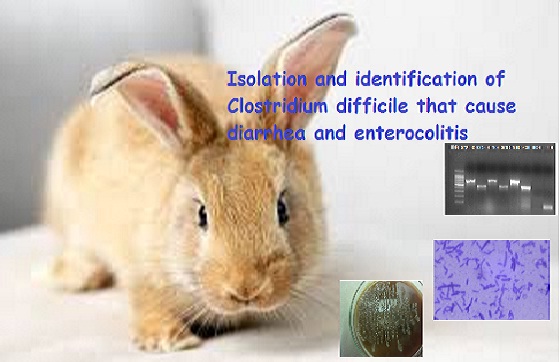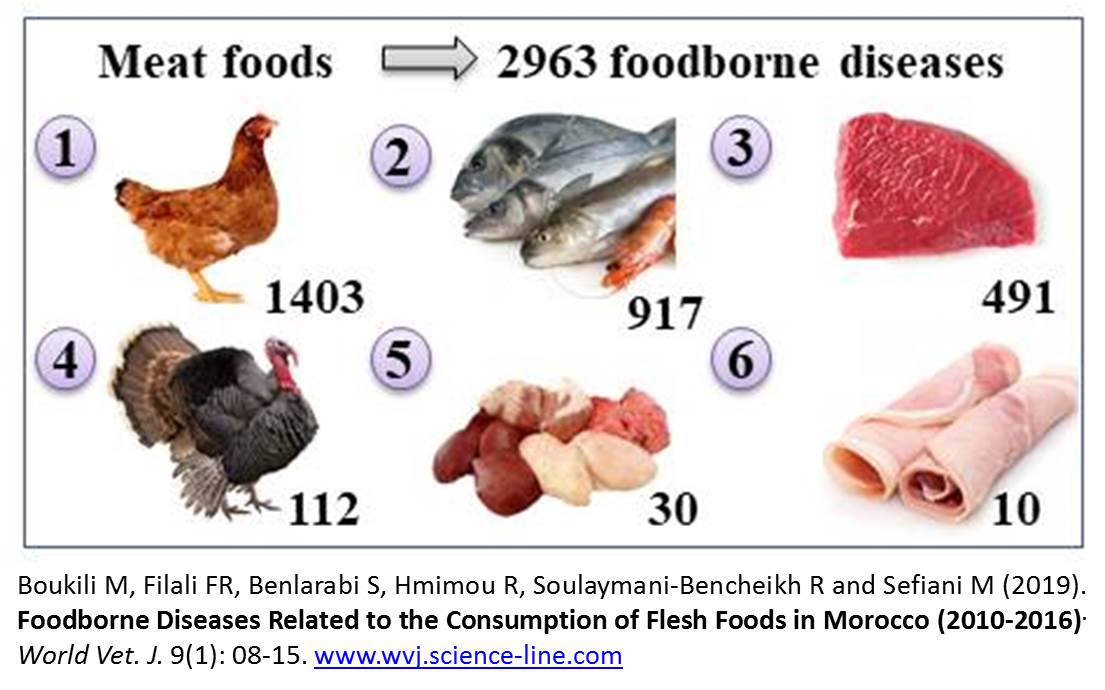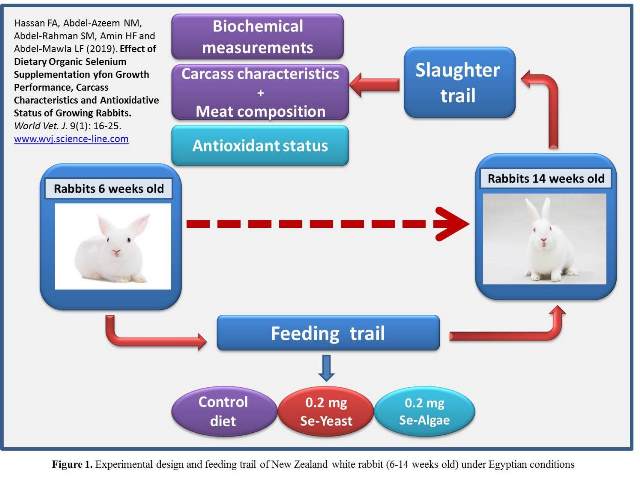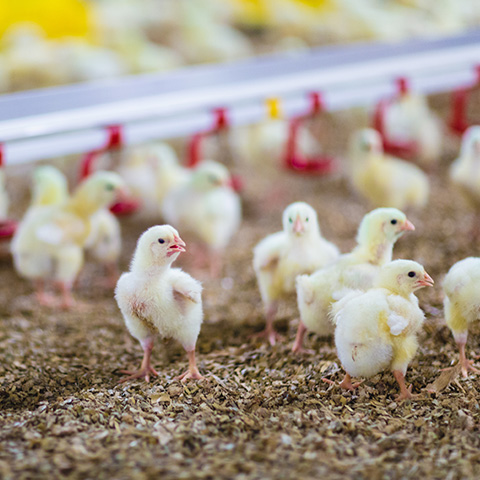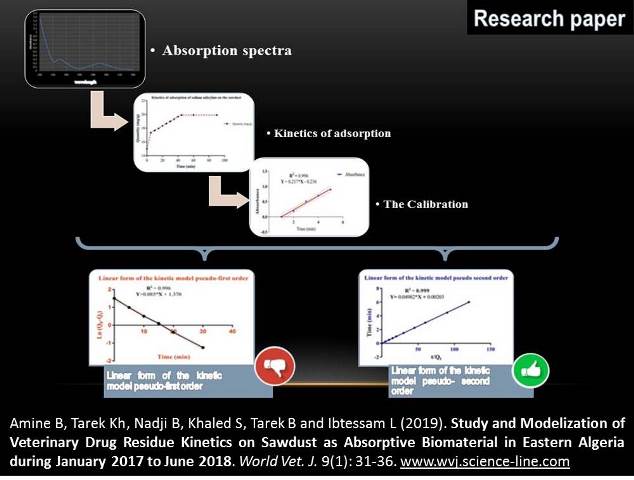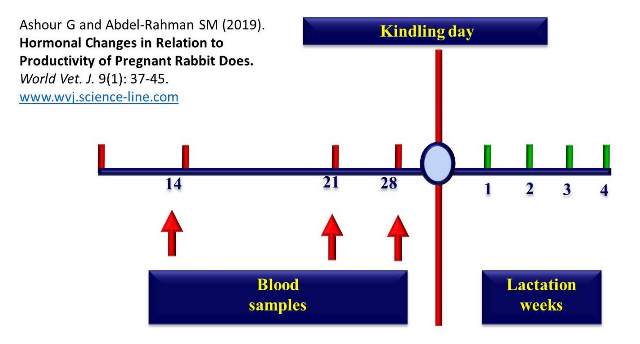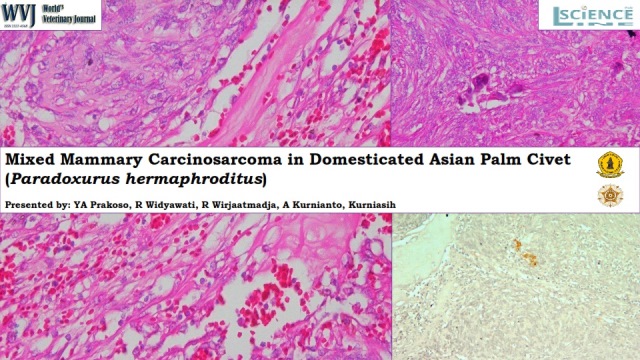Previous issue | Next issue | Archive
![]() Volume 9 (1); March 25, 2019 [Booklet] [EndNote XML for Agris]
Volume 9 (1); March 25, 2019 [Booklet] [EndNote XML for Agris]
Identification of Locally Isolated Clostridium difficile from Rabbits.
Taha MM, El-Helw HA, El-Sergany EF, El Sawy H, Abdella YA and El-Meneisy AA.
World Vet. J. 9(1): 01-07, 2019; pii:S232245681900001-9
DOI: https://dx.doi.org/10.36380/scil.2019.wvj1
ABSTRACT
Clostridium difficile is one of the most important pathogens causing diarrhea and enteritis in rabbits as it causes pseudomembranous colitis that leads to intestinal damage and deaths. In this study, screening of rabbit farms from different localities in Egypt had shown rabbits suffered from diarrhea and enteritis to detect Clostridium difficile by ELISA, it revealed that five out of 50 samples (10%) were positive for it. These samples were further identification by cultivation and culture characters, microscopical examination, agglutination test, pathogenicity test and Polymerase Chain Reaction (PCR) by using specific primers for toxins genes (tcdA and tcdB). The results showing that three out of five isolates were confirmed as Clostridium difficile and concluded that these isolates causing pseudomembranous enterocolitis in rabbits and this disease unable to be treated by antibiotics, so it used for preparation of vaccine against the disease in rabbits.
Keywords: Clostridiunm difficile, Rabbits, Enteritis
[Full text-PDF] [XML] [Import into EndNote] [Citations on Google Scholar]
Foodborne Diseases Related to the Consumption of Flesh Foods in Morocco (2010-2016).
Boukili M, Filali FR, Benlarabi S, Hmimou R, Soulaymani-Bencheikh R and Sefiani M.
World Vet. J. 9(1): 08-15, 2019; pii:S232245681900002-9
DOI: https://dx.doi.org/10.36380/scil.2019.wvj2
ABSTRACT
The current study aimed to determine the epidemiological profile of foodborne diseases associated with flesh foods during 2010-2016 in Morocco. A retrospective study of foodborne diseases caused by flesh foods recorded by the Moroccan anti-poison and pharmacovigilance center during 2010-2016. During this period, 2963 foodborne diseases related to flesh foods were declared to the center, in which 24.83% were registered in 2015, and 20.75% in 2013. Diseases occurred mostly in urban areas (67.06%). The major affected group’s ages were adults (33.81%) and children (14.44%). The average patient’s age was 25.09 ± 15.37 years. Male were the most vulnerable to infection (54.80%) with a sex ratio (male / female) of 1.72. The most incriminate flesh foods were respectively chicken (47.35%), aquatic products (30.94%) and red meat (16.57%). The high incidence rate was related to chicken skewers (3.55 per 100000 people), while the high fatality rate was associated with giblets (3.33%). Diseases due to the restauration outside home accounted for 58.15%. The majority of cases were collective (84.27%) and occurred significantly in spring (18.49%) and summer (14.51%). clinical symptoms were present in 67.19 % of cases, mostly moderate (81.77%) with four death cases corresponding to fatal condition. The high incidence rates were recorded in the regions of Sahara. Foodborne diseases are spreading progressively in Morocco, especially in summer and hot climates. The majority of these diseases are due to the consumption of contaminated flesh foods. Therefore, the responsible of food safety in Morocco must ensure the quality control of these foodstuffs.
Keywords: Epidemiology, Foodborne diseases, Meat, Morocco
[Full text-PDF] [XML] [Import into EndNote] [Citations on Google Scholar]
Effect of Dietary Organic Selenium Supplementation on Growth Performance, Carcass Characteristics and Antioxidative Status of Growing Rabbits.
Hassan FA, Abdel-Azeem NM, Abdel-Rahman SM, Amin HF and Abdel-Mawla LF.
World Vet. J. 9(1): 16-25, 2019; pii:S232245681900003-9
DOI: https://dx.doi.org/10.36380/scil.2019.wvj3
ABSTRACT
Total of 45 weaned male New Zealand White (NZW) rabbits about six weeks old with an average initial body weight 618.11±10.01g were randomly allotted to three dietary groups; the first group fed the basal diet without organic Se, the second fed basal diet +0.2 mg Se-yeast, the third fed basal diet +0.2 mg Se-algae. The obtained results showed that supplementation rabbit diets with Se-yeast and Se-algae have no impact on final body weight and average daily body weight gain. Se-algae supplementation tended to increase (P < 0.05) average daily feed intake. Rabbits group fed diet supplemented with Se-yeast achieved better (P<0.05) FCR than that group fed Se-algae (5.06 g feed/g gain). Supplementation of Se-algae at 0.2 mg was the highest (P < 0.05) in total protein, albumin, and globulin concentration (7.94, 4.16 and 3.78 g/dl). Diets supplemented with Se-yeast or Se-algae significantly reduced plasma creatinine levels compared to the control group. All recorded values of creatinine and urea concentrations were within the normal ranges. Dietary supplementation with 0.2 mg Se-yeast or Se-algae resulted in a significant (P < 0.05) decrease in the activity of AST enzyme. Plasma total cholesterol and plasma LDL levels were significantly decreased (P < 0.05) with dietary supplementation with Se-yeast or Se-algae. There was a significant (p < 0.05) decrease in plasma MDA level in rabbits fed diets supplemented with Se-yeast or Se-algae. While Catalase activity was significantly (P < 0.05) increased. Rabbits fed diet supplemented with Se-algae was the lowest (P < 0.05) group in ether extract meat content while dietary supplementation of Se-algae significantly increased (P < 0.05) Se content of rabbits meat of hind leg. Conclusively, Se-yeast and Se-algae can be used as selenium sources in growing rabbit diets without causing any adverse effects on growth performance. Besides, their beneficial effects in improving the antioxidative status.
Keywords: Anti-oxidative status, Carcass, Growth, Organic selenium, Rabbit
[Full text-PDF] [XML] [Import into EndNote] [Citations on Google Scholar]
Effect of Environmental Heat Stress on Performance and Carcass Yield of Broiler Chicks.
Yousaf A, Jabbar A, Rajput N, Memon A, Shahnawaz R, Mukhtar N, Farooq F, Abbas M and Khalil R.
World Vet. J. 9(1): 26-30, 2019; pii:S232245681900004-9
DOI: https://dx.doi.org/10.36380/scil.2019.wvj4
ABSTRACT
Environmental heat stress is one of the most challenging conditions which have adverse effect on the poultry industry. Broiler chickens are sensitive to heat stress mainly due to not having sweat glands. The current study was conducted to observe the effect of heat stress on performance of Ross-308 broiler chickens. 1600 Ross-308 broiler day old chicks were obtained from local hatchery and randomly divided into two groups, the heat stress group A (n = 800) and heat free group B (n = 800). Group A was reared in high temperature (1010F) whereas group B was reared in ideal temperature. To evaluate the physiological stress indicators blood glucose levels and total blood cell count were checked on day 21 and 28. The parameters observed were; feed intake, body weight gain, feed conversion ratio, water intake and carcass yield. The results indicated that feed intake, weight gain, water intake, feed conversion ratio and carcass yield were significantly higher in group B compared to group A. It was concluded that heat stress has deleterious effect over the performance of broiler Ross-308 chicken.
Keywords: Broiler Ross-308, Carcass yield, Environmental, Heat stress, Performance
[Full text-PDF] [XML] [Import into EndNote] [Citations on Google Scholar]
Study and Modelization of Veterinary Drug Residue Kinetics on Sawdust as Absorptive Biomaterial in Eastern Algeria during January 2017 to June 2018.
Amine B, Tarek Kh, Nadji B, Khaled S, Tarek B and Ibtessam L.
World Vet. J. 9(1): 31-36, 2019; pii:S232245681900005-9
DOI: https://dx.doi.org/10.36380/scil.2019.wvj5
ABSTRACT
Sawdust, an affordable resource, is being investigated as an adsorbent to eliminate residual contaminants from water. Wood processing residues such as bark and sawdust have been widely studied for some years for their adsorption and removal properties of toxic metals contained in contaminated effluents. The aim of our study is to know the source of chemical contamination of water by using spectrophotometry methods in field ultraviolet, the kinetic study of sodium salicylate adsorption on sawdust was modelized according to two kinetic models (pseudo first and second order), to determine the most optimal pattern to describe this phenomenon, was based in the comparison on the correlation coefficient (R2) between the absorbance and the wavelength for both models and evaluate the optimal time of contact solid/liquid. Present results indicated that the correlation coefficient (R2 = 0.999) for the pseudo-second order, which means that this model is the best for future studies in the kinetics of adsorption of sodium salicylate by sawdust, with a time of contact solid /liquid optimal is 44.5 minutes.
Keywords: Residual contaminants, Sodium salicylate, Spectrophotometry, Veterinary drugs
[Full text-PDF] [XML] [Import into EndNote] [Citations on Google Scholar]
Hormonal Changes in Relation to Productivity of Pregnant Rabbit Does.
Ashour G and Abdel-Rahman SM.
World Vet. J. 9(1): 37-45, 2019; pii:S232245681900006-9
DOI: https://dx.doi.org/10.36380/scil.2019.wvj6
ABSTRACT
Pregnancy is a critical period for animals where it undergoes many physiological changes including hormones, which are not received a great attention in rabbit. Therefore, a total number of 25 New Zealand White pregnant rabbit does were used, to assess the changes in concentration of relevant hormones in relation to rabbit productivity. Blood samples were collected on 14, 21 and 28 days of pregnancy and on kindling day to quantify six maternal hormones. Litter size and weight, in addition to average of weekly and total milk yield were determined. Concentrations of the six hormones during the second half of pregnancy ranged between 3.2 to 4.0 ng/ml for progesterone (P4), 47.3 to 89.0 pg/ml for estrogen (E2), 2.0 to 3.7 ng/ml for prolactin (PRL), 114.5 to 136.8 ng/ml for insulin like growth factor-I (IGF-I), 36.0 to 39.2 ng/ml for thyroxine (T4) and 1.9 to 2.2 ng/ml for triiodothyronine (T3). The corresponding values on kindling day were 1.6 ng/ml, 26.8 pg/ml, 4.6 ng/ml, 131.6 ng/ml, 37.4 ng/ml and 0.9 ng/ml, respectively. At day 14, maternal P4, E2, PRL, T4 and T3 were the lowest, whereas IGF-I was the highest compared to the other two days of pregnancy. At day 28, levels of E2, PRL, T4 and T3 were the highest in comparison with days 14 and 21 of pregnancy. On kindling day, P4 and T3 showed the minimal levels, whilst PRL exhibited the maximal level compared to the levels at all the gestational days. The relationship among the different hormones had various trends. The average of total milk yield (129.9 g/d) was negatively correlated with both P4 and E2, and positively associated with the PRL, IGF-I, T4 and T3 hormones. Furthermore, litter size was positively related with P4, E2 and PRL, and negatively with T4, T3 and IGF-I. Whereas, litter weight was negatively correlated with P4, E2 and T4. We recommend giving more attention to the rabbit doe reproduction, particularly close to parturition to achieve good economical return. However, further studies are urgently needed in this area.
Keywords: Hormones, Litter size, Litter weight, Milk production, Pregnancy, Rabbits
[Full text-PDF] [XML] [Import into EndNote] [Citations on Google Scholar]
Mixed Mammary Carcinosarcoma in Domesticated Asian Palm Civet (Paradoxurus hermaphroditus).
Prakoso YA, Widyawati R, Wirjaatmadja R, Kurnianto A and Kurniasih.
World Vet. J. 9(1): 46-51, 2019; pii:S232245681900007-9
DOI: https://dx.doi.org/10.36380/scil.2019.wvj7
ABSTRACT
A female Asian palm civet (Paradoxurus hermaphroditus), three years old was carried for a medical checkup to Ruddy animal's clinic in Sidoarjo, East Java, Indonesia. The civet suffers enlargement of abdominal mammary glands, painless lump, asymmetric size (4.1 and 8.4 cm in diameter), and lacerated wound on the large one with severe haemorrhage. The unilateral mastectomy was conducted under anaesthesia to handles both haemorrhage and tumour mass. Following the surgery, the tumour mass was stored in 10% neutral buffer formalin for histopathology using Hematoxylin & Eosin (H&E) staining and immunohistochemistry against antibody, anti-CD4+ and CD8+, further, a blood sample collected before and after surgery (on days: 0, 7, 30, and 60) for representing the healing progress. The chemotherapy was given using the combination of oral cyclophosphamide and intravenous injection of vincristine. According to laboratory results, the final diagnosis was mixed mammary carcinosarcoma with minimal expression of CD8+, notwithstanding, it showed the better prognosis after surgery and chemotherapy.
Keywords: Asian palm civet, CD4+, CD8+, Mixed mammary carcinosarcoma, Therapy
[Full text-PDF] [XML] [Import into EndNote] [Citations on Google Scholar]
Previous issue | Next issue | Archive
![]() This work is licensed under a Creative Commons Attribution 4.0 International License (CC BY 4.0).
This work is licensed under a Creative Commons Attribution 4.0 International License (CC BY 4.0).



